
Operation Cycle is the name of the evacuation of Allied troops from Le Havre, in the Pays de Caux of Upper Normandy from 10 to 13 June 1940, towards the end of the Battle of France, during the Second World War. The operation was preceded by the better known rescue of 338,226 British and French soldiers from Dunkirk in Operation Dynamo (26 May – 4 June). On 20 May, the Germans had captured Abbeville at the mouth of the Somme and cut off the main Allied armies in the north. South of the river, the Allies improvised defences and made local counter-attacks to dislodge the Germans from bridgeheads on the south bank and re-capture river crossings, for an advance northwards to regain contact with the armies in northern France and Flanders.
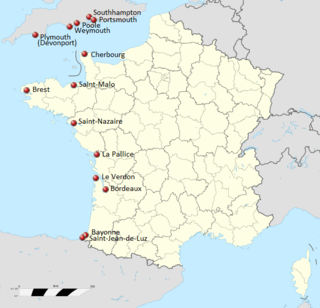
Operation Aerial was the evacuation of Allied military forces and civilians from ports in western France. The operation took place from 15 to 25 June 1940 during the Second World War. The embarkation followed the Allied military collapse in the Battle of France against Nazi Germany. Operation Dynamo, the evacuation from Dunkirk and Operation Cycle from Le Havre, had finished on 13 June. British and Allied ships were covered from French bases by five Royal Air Force (RAF) fighter squadrons and assisted by aircraft based in England to lift British, Polish and Czech troops, civilians and equipment from Atlantic ports, particularly from St Nazaire and Nantes.
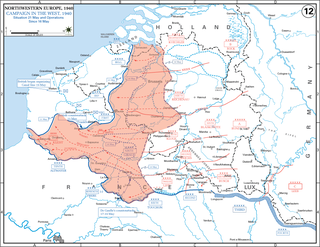
The Battle of Arras took place on 21 May 1940, during the Battle of France in the Second World War. Following the German invasion of the Low Countries on 10 May, French and British forces advanced into Belgium. The German campaign plan Fall Gelb had evolved into a decoy operation in the Netherlands and Belgium, with the main effort through the Ardennes. German units crossed the Meuse without waiting for reinforcements at the Battle of Sedan. Instead of consolidating bridgeheads on the west bank of the Meuse, the Germans began an advance down the Somme river valley towards the English Channel.
The 150th Infantry Brigade was an infantry formation of the British Army that saw active service in the Second World War. A 1st Line Territorial Army brigade, it was part of the 50th (Northumbrian) Infantry Division. It served in the Battle of France and was evacuated from Dunkirk. Later it served in the Middle East and was overrun and forced to surrender during the Battle of Gazala in the North African Campaign. For almost 72 hours during the battle the 150th Brigade and the 44th Royal Tank Regiment held out against Erwin Rommel's concentrated attacks, without any support. On 1 June the German Army finally forced their surrender. The brigade was not reformed.
The 151st Infantry Brigade was an infantry brigade of the British Army that saw active service during the Second World War in Belgium and France in 1940, and later in North Africa, Tunisia and Sicily, and later in Normandy in mid-1944 and North-western Europe. The brigade was part of the 50th (Northumbrian) Infantry Division, and for most of its wartime existence consisted of three battalions of the Durham Light Infantry (DLI) the 6th, 8th and 9th.

The 2nd Infantry Brigade was a regional brigade of the British Army, active since before the First World War. It was the regional formation of the Army in the South East of England–the Brigade commanded and administered soldiers throughout Kent, Surrey and Sussex–but also Brunei. In December 2014 the Brigade merged with 145 (South) Brigade to form Headquarters 11th Infantry Brigade and Headquarters South East.
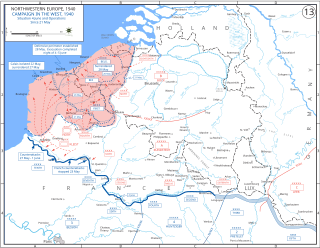
The Siege of Calais (1940) was a battle for the port of Calais during the Battle of France. The siege was fought at the same time as the Battle of Boulogne, just before Operation Dynamo, the evacuation of the British Expeditionary Force (BEF) through Dunkirk. After the Franco-British counter-attack at the Battle of Arras, German units were held back to be ready to resist a resumption of the counter-attack on 22 May, despite the protests of General Heinz Guderian, the commander of the XIX Armee Korps, who wanted to rush north up the Channel coast to capture Boulogne, Calais and Dunkirk. An attack by part of the XIX Armee Korps was not authorised until 12:40 a.m. on the night of 21/22 May.

The 23rd (Northumbrian) Division was an infantry division of the British Army, which fought briefly in the Battle of France during the Second World War. In March 1939, after the re-emergence of Germany as a European power and its occupation of Czechoslovakia, the British Army increased the number of divisions within the Territorial Army by duplicating existing units. The 23rd (Northumbrian) Division was formed in October 1939, as a second-line duplicate of the 50th (Northumbrian) Motor Division. It was made up of two brigades, unlike regular infantry divisions that were composed of three, with battalions hailing from the north of England.

The 59th (Staffordshire) Infantry Division was an infantry division of the British Army that was formed during the Second World War and fought in the Battle of Normandy. In March 1939, after Germany re-emerged as a significant military power and invaded Czechoslovakia, the British Army increased the number of divisions in the Territorial Army (TA) by duplicating existing units. The 59th (Staffordshire) Motor Division was formed in September 1939, as a second-line duplicate of the 55th Motor Division. The division's battalions were all, initially, raised in Staffordshire.
The 70th Infantry Brigade was an infantry brigade of the British Army that saw service during both the First and Second World War and postwar.
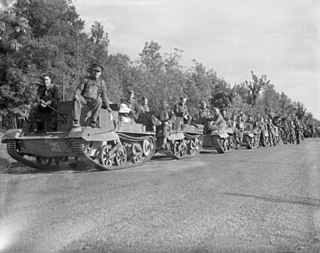
The British Expeditionary Force (BEF) was the contingent of the British Army sent to France in 1939 after Britain and France declared war on Nazi Germany on 3 September, beginning the Second World War. The BEF existed from 2 September 1939 when the BEF GHQ was formed until 31 May 1940, when GHQ closed down and its troops reverted to the command of Home Forces. During the 1930s, the British government had planned to deter war by abolishing the Ten Year Rule and rearming from the very low level of readiness of the early 1930s. The bulk of the extra money went to the Royal Navy and the Royal Air Force but plans were made to re-equip a small number of Army and Territorial Army divisions for service overseas.
The Battle of Monte Cassino order of battle for January 1944, is a listing of the significant formations involved in the fighting on the Winter Line January 1944, during the period generally known as the First Battle of Monte Cassino.
Second Battle of Monte Cassino order of battle February 1944 is a listing of the significant formations that were involved in the fighting on the Winter Line in February 1944 during the period generally known as the Second Battle of Monte Cassino.

The 126th Brigade was an infantry brigade of the British Army during the First World War and the Second World War. It was assigned to the 42nd Division and served in the Middle East and on the Western Front in the Great War. In the Second World War, now as the 126th Infantry Brigade, it served again with the 42nd Division in France and was evacuated at Dunkirk and then later converted into 11th Armoured Brigade.
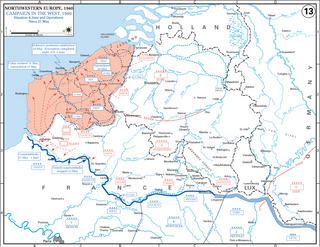
The Battle of Abbeville took place from 27 May to 4 June 1940, near Abbeville during the Battle of France in the Second World War. On 20 May, the 2nd Panzer Division advanced 56 mi (90 km) to Abbeville on the English Channel, overran the 25th Infantry Brigade of the 50th (Northumbrian) Infantry Division and captured the town at 8:30 p.m. Only a few British survivors managed to retreat to the south bank of the Somme and at 2:00 a.m. on 21 May, the III Battalion, Rifle Regiment 2 reached the coast, west of Noyelles-sur-Mer.

The 12th (Eastern) Infantry Division was an infantry division of the British Army, which fought briefly in the Battle of France during the Second World War. In March 1939, after the re-emergence of Germany as a European power and its occupation of Czechoslovakia, the British Army increased the number of divisions within the Territorial Army by duplicating existing units. The 12th (Eastern) Infantry Division was formed in October 1939, as a second-line duplicate of the 44th Infantry Division.

The Battle of Boulogne in 1940 was the defence of the port of Boulogne-sur-Mer by French, British and Belgian troops in the Battle of France during the Second World War. The battle was fought at the same time as the Siege of Calais, just before Operation Dynamo, the evacuation of the British Expeditionary Force (BEF) from Dunkirk. After the Franco-British counter-attack at the Battle of Arras on 21 May, German units were held ready to resist a resumption of the attack on 22 May. General der Panzertruppe (Lieutenant-General) Heinz Guderian, the commander of XIX Corps, protested that he wanted to rush north up the Channel coast to capture Boulogne, Calais and Dunkirk. An attack by part of XIX Corps was not ordered until 12:40 p.m. on 22 May, by which time the Allied troops at Boulogne had been reinforced from England by most of the 20th Guards Brigade.

The 1st Armoured Division was an armoured division of the British Army. It was formed as the Mobile Division on 24 November 1937, after several years of debate on the creation of such a formation. It was then renamed, in April 1939, the 1st Armoured Division. Following the start of the Second World War, in September 1939, subordinate units and formations were withdrawn from the division to reinforce others. Then, in May 1940, the division was deployed to France and then fought in the Battle of France. After several engagements and heavy tank losses, it was forced to withdraw to the UK, in June, during Operation Aerial. In late 1941, the division was sent to North Africa where it took part in the Western Desert campaign, notably fighting at the Battle of Gazala, and the First and the Second Battles of El Alamein.
Brigadier Archibald Bentley Beauman CBE DSO and Bar was a British Army officer, who at the start of the Second World War, raised and commanded an improvised force of second-line troops called the Beauman Division, in an attempt to stem the German Blitzkrieg during the Battle of France.

Arkforce was an ad hoc formation of the British Expeditionary Force during the Battle of France in 1940.


















